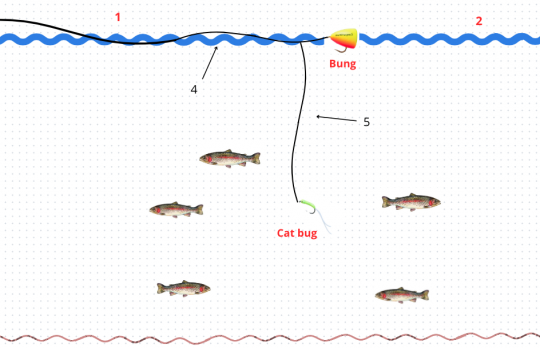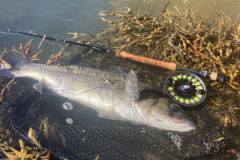Reservoir fishing is often practised using active methods where we animate various flies by gradually bringing them towards us at different speeds to cover ground and find fish in the different water layers of a lake or reservoir.
Bung is a technique that does just the opposite!
This is static fishing, which allows you to present your flies (usually 1 to 3) at a certain height of water, and keep them there.
It's literally cork fishing, although the bung can be replaced by a high-float fly, which won't have the same advantages (visibility, flotation, etc.).
When trout are less active or less receptive to the various streamers, chiros, nymphs and other flies animated and stripped, bung fishing offers an option or one more string to one's bow. It allows a complete change of presentation and can sometimes be very effective, especially on fish overfished using conventional techniques.

How to fish with bung?
- The equipment
The most common rod is a 9.6 or 10-foot 7 or 8 silk, depending on casting ability and conditions.
This rod length allows you to use a fairly long leader, especially when fishing at a certain depth. It also facilitates casts, which are generally made at short to medium distance.
A WF line will make it easier to cast this rig. There's no great finesse in the rig, although small flies can be presented on fairly fine threads if necessary, such as a train of 3 chiros (in the case of a hookless bung).
A short leader (tapering or made up of a single diameter of line from 1.5 to 3 m) is the norm, as it is important to keep the line taut and will allow you to respond quickly to a strike with an ultra-fast strike.
The tip will depend on the conditions, water color, mistrust and size of the fish you're after. We generally use 16° or 18°, but it can be 14° or 20°.
- The benefits
The main advantage is to suspend one or two flies at a defined height. As the bung is armed with a hook, legislation in France only allows the use of 3 flies.
The fly(s) will be static and remain in the water layer(s) in which the fish are active.
However, from time to time, the rod can be lifted to slightly raise and lower the flies, which then reposition themselves. This animation can sometimes be radical, especially when chironomid larvae are used.

- Disadvantages
This rig is not the easiest to cast, especially if you need to fish at depths in excess of two meters and with weighted flies.
When you need to fish with a tippet at a depth greater than the length of the rod, you'll need to lift your arm well and be in possession of a long-handled landing net to retrieve your fish.
We don't cover a lot of water, but that's the way the technique works.
Mounts for bung fishing
Fishing is often done with one or two flies.
A single fly makes it possible to offer an unobtrusive set-up, especially when the fish are under a lot of pressure, which can make all the difference.
The advantage of using a two-fly rig is to offer two different flies, and above all to be able to fish at two different depths.
Single fly tying:

1- Silk
2- Water surface
4- Short or single-strand tapered leader from 1 to 2 m in 16° or 18°
5- Nylon/fluorocarbon 16° to 18°- 1 or 2 m or more depending on fish depth
Tying with two flies:

1- Silk
2- Water surface
3- Background
4- Short or single-strand tapered leader from 1 to 2 m in 16° or 18°
5- Nylon/fluorocarbon 16° to 18°- 1 or 2 m or more depending on fish depth
6- 10-15 cm stem, same diameter
7- Surgeon's knot
There are many possibilities in terms of flies to use. Here are some of the most commonly used:
Cat bung, egg, squirmy worm, wormapps, helmeted nymphs, eggstasy mop fly, eggastasy streamer, blob,...
But you can also use a train of 2 or 3 chiros. It all depends on the number of flies allowed, bearing in mind that the bung is often mounted on a hook (which is compulsory in competition). In the case of a true indicator or cork, 3 flies can be used.

 /
/ 






